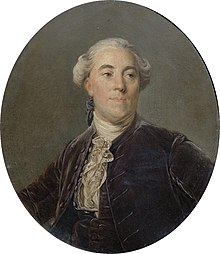Jacques Necker
| Jacques Necker | |
|---|---|
 |
|
| Chief Minister of the French Monarch | |
|
In office 16 July 1789 – 3 September 1790 |
|
| Monarch | Louis XVI |
| Preceded by | Baron of Breteuil |
| Succeeded by | Count of Montmorin |
|
In office 25 August 1788 – 11 July 1789 |
|
| Monarch | Louis XVI |
| Preceded by | Archbishop de Brienne |
| Succeeded by | Baron of Breteuil |
| Controller-General of Finances | |
|
In office 25 August 1788 – 22 July 1789 |
|
| Monarch | Louis XVI |
| Preceded by | Claude Lambert |
| Succeeded by | Claude Lambert |
|
In office 29 June 1777 – 19 May 1781 |
|
| Monarch | Louis XVI |
| Preceded by | Louis Gabriel Taboureau |
| Succeeded by | Jean-François Joly |
| Personal details | |
| Born |
30 September 1732 Geneva, Republic of Geneva, Switzerland |
| Died | 9 April 1804 (aged 71) Coppet, Vaud, Switzerland |
| Political party | Non-partisan (Reformist) |
| Spouse(s) | Suzanne Curchod (m. 1764–94); her death |
| Children | Germaine |
| Profession | Banker, statesman |
| Religion | Calvinism |
Jacques Necker (IPA: [ʒak nɛkɛʁ]; 30 September 1732 – 9 April 1804) was a Swiss banker who became a French statesman and finance minister for Louis XVI. He held the finance post during the period 1777-1781 and helped make decisions that were critical in creating political and social conditions that contributed to the outbreak of the French Revolution in 1789. He was recalled to royal service just before the Revolution actually did start, but remained in office for only a brief period of time. His elder brother was the mathematician Louis Necker (1730–1804).
Necker was born in Geneva, at that time an independent republic. His father, Karl Friedrich Necker, was a native of Küstrin in Neumark, Prussia (now Kostrzyn nad Odrą, Poland). After the publication of some works on international law, he was elected a professor of public law at Geneva, of which he became a citizen. Jacques Necker was sent to Paris in 1747 to become a clerk in the bank of Isaac Vernet, a friend of his father. In 1762, he became a partner and by 1765, he had become very wealthy through successful financial speculations. Soon, he co-founded the bank of Thellusson, Necker et Compagnie with another Genevese, Peter Thellusson. Thellusson (also known as Pierre Thellusson) superintended the bank in London (his son was made a peer as Baron Rendlesham), while Necker was managing partner in Paris. Both partners became very rich by means of loans to the French treasury and speculations in grain.
In 1763, Necker fell in love with Madame de Verménou, the widow of a French officer. But while on a visit to Geneva, Madame de Verménou met Suzanne Curchod, who was the daughter of a pastor near Lausanne and had been engaged to Edward Gibbon. In 1764, Madame de Verménou brought Suzanne to Paris as her companion. There Necker, transferring his love from the wealthy widow to the poor Swiss girl, married Suzanne before the end of the year. On 22 April 1766, they had a daughter, Anne Louise Germaine Necker, who became a renowned author under the name of Madame de Staël.
...
Wikipedia
